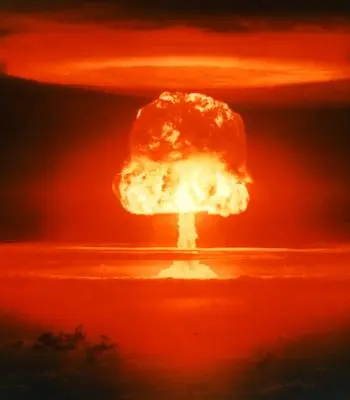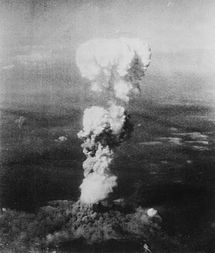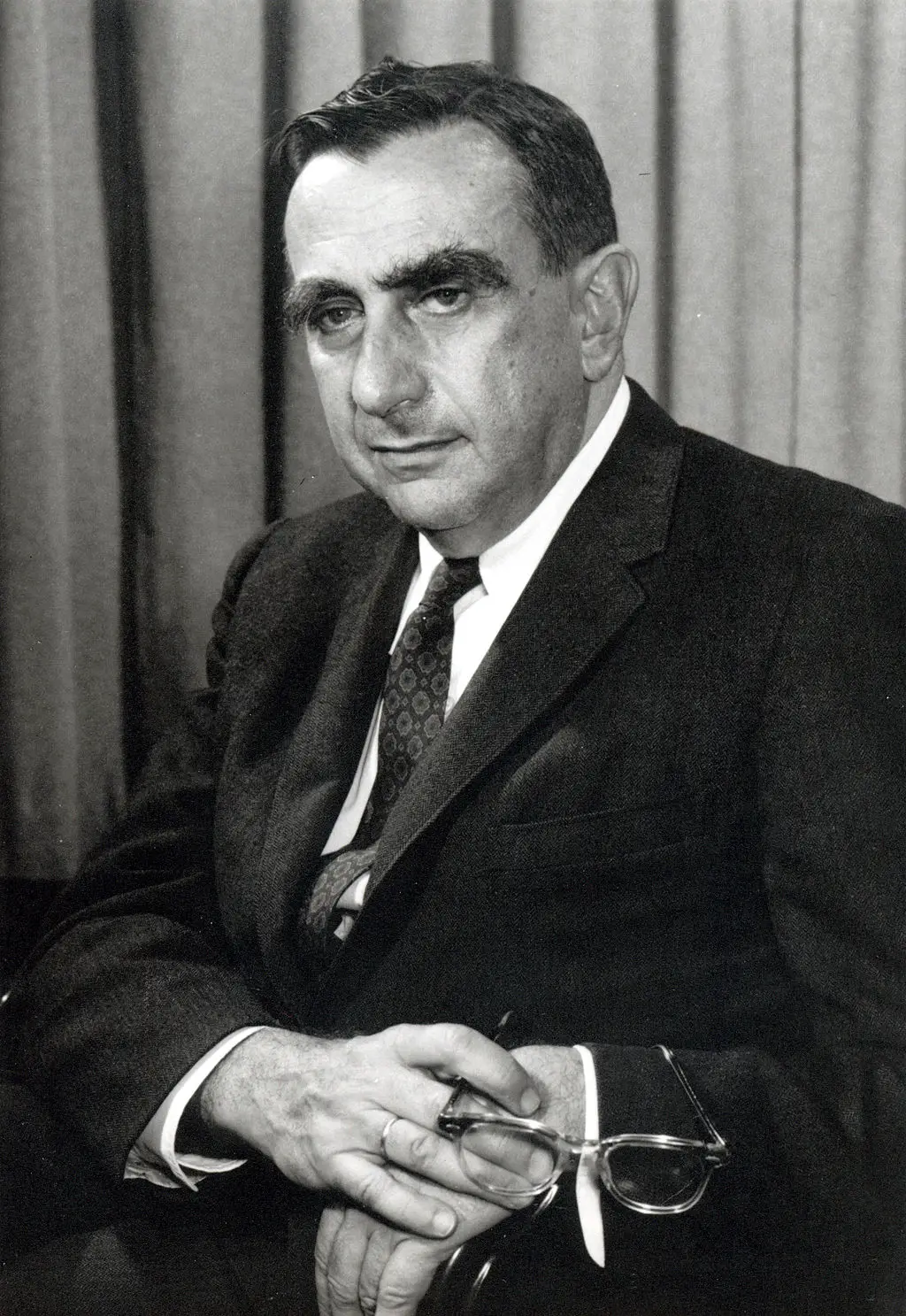
A hydrogen bomb , also known as a thermonuclear bomb or fusion bomb, is an explosive device that uses the energy released by the nuclear fusion of hydrogen to generate an extremely powerful explosion.
Unlike conventional nuclear bombs, which work through nuclear fission (splitting of heavy atoms), hydrogen bombs take advantage of nuclear fusion (union of light atoms) to release a much greater amount of energy.
Hydrogen bomb operation
 The basic process of a hydrogen bomb involves two main stages:
The basic process of a hydrogen bomb involves two main stages:
Detonator fission
As in a conventional nuclear bomb, a small fission bomb is used to generate an initial amount of energy.
This process is achieved by splitting heavy atomic nuclei, such as uranium or plutonium. This stage generates high temperatures and pressures that are necessary to initiate fusion in the next stage.
Thermonuclear fusion
At this stage, the energy released by fission of the detonator is used to compress and heat hydrogen, which is usually in the form of heavy isotopes of hydrogen, such as deuterium and tritium.
The resulting high temperatures and pressures cause the hydrogen nuclei to fuse, releasing an immense amount of energy in the form of radiation and highly energetic particles.
Power of a thermonuclear bomb
Hydrogen bombs are the most powerful explosive weapons that exist. Its power is measured in equivalent terms of tons of TNT, a conventional unit of explosive energy.
Fusion bombs can have output on the megaton scale, meaning they can release the energy equivalent of millions of tons of TNT.
Examples of power
Below are some historical examples of hydrogen bombs and their performance:
-
Ivy Mike Hydrogen Bomb (1952): The first hydrogen bomb detonated by the United States had an estimated yield of around 10 megatons.
-
Tsar Hydrogen Bomb Bomb (1961): The most powerful hydrogen bomb ever detonated was developed by the Soviet Union and had an estimated maximum yield of approximately 50 megatons. However, to reduce the environmental impact, its pre-detonation yield was reduced to around 30-40 megatons.
-
Castle Bravo Hydrogen Bomb (1954): This American bomb had a yield of around 15 megatons, but its explosion was much more powerful than expected due to an unexpected reaction in the design.
Comparison with the atomic bomb
Comparatively, hydrogen bombs are much more powerful than the nuclear fission bombs used in Hiroshima and Nagasaki.
Hydrogen bombs are dozens of times more powerful than the Hiroshima and Nagasaki bombs. For example, a hydrogen bomb with a yield of 1 megaton would be approximately 66 times more powerful than the Nagasaki bomb.
Differences with the atomic bomb
 Thermonuclear bombs and atomic bombs are two types of nuclear weapons that use nuclear processes to release energy in the form of an explosion. However, they have fundamental differences in how they release this energy and in their potency.
Thermonuclear bombs and atomic bombs are two types of nuclear weapons that use nuclear processes to release energy in the form of an explosion. However, they have fundamental differences in how they release this energy and in their potency.
Here are the main differences between the two:
Nuclear process used
-
Atomic Bomb (Fission): Atomic bombs work through the process of nuclear fission, in which heavy atomic nuclei, such as uranium or plutonium, are divided. This releases a significant amount of energy in the form of radiation, heat and a blast wave.
-
Thermonuclear Bomb (Fusion): Thermonuclear bombs work through the process of nuclear fusion, where light atomic nuclei, usually isotopes of hydrogen, combine to form a heavier nucleus. This process releases a much larger amount of energy compared to fission.
Power
Thermonuclear (fusion) bombs are significantly more powerful than atomic (fission) bombs. Hydrogen bombs have ratings on the megaton scale, equivalent to millions of tons of TNT, while atomic bombs typically have ratings on the kiloton scale, equivalent to thousands of tons of TNT.
Design and structure
- Atomic bombs are generally simpler in design and construction. They usually require less technical sophistication for their development and detonation.
- Thermonuclear bombs are more complex due to fusion processes involving extremely high temperatures and pressures. These bombs contain multiple stages and use the energy released by a fission bomb as a detonator to start the fusion reaction.
Effects and consequences
- Thermonuclear bombs have a much greater potential for destruction compared to atomic bombs. Its destructive capacity extends to a wider area and produces more intense and extensive radiation.
- Atomic bombs also cause significant destruction and generate radiation, but their impact is relatively minor compared to thermonuclear bombs.
Use and international treaties
Atomic bombs were the first to be developed and used in real conflicts, such as the attacks on Hiroshima and Nagasaki during World War II. The development of these bombs occurred within the Manhattan project led by physicist Robert Oppenheimer.
Thermonuclear bombs, because of their much greater potential to cause devastation, have been subject to stricter regulations and international nuclear arms control treaties.
Who developed the hydrogen bomb?
The hydrogen bomb, also known as a thermonuclear bomb, was developed independently by several teams of scientists in different countries during the 1950s. However, the two main drivers of its development were the United States and the Soviet Union.
USA
 The development of the hydrogen bomb in the United States relied heavily on the work of physicist Edward Teller and other scientists under Project Ivy.
The development of the hydrogen bomb in the United States relied heavily on the work of physicist Edward Teller and other scientists under Project Ivy.
The first successful test of a hydrogen bomb by the United States was called "Ivy Mike" and took place in 1952. It was a bomb of enormous dimensions and its design used a small fission bomb to compress and heat a fusion material of hydrogen.
This test marked the beginning of the era of thermonuclear weapons.
Soviet Union
The Soviet Union also worked on the development of the hydrogen bomb in parallel. Its first successful test, called "Joe-4" or "RDS-6s", was carried out in 1953. The bomb used a design similar to that of the United States, with a fission stage to generate the high temperatures and pressures necessary to nuclear fusion.
What countries have the hydrogen bomb?
To this day several countries have developed and tested hydrogen bombs (thermonuclear bombs):
- United States: Was one of the first countries to develop the hydrogen bomb and has had an advanced nuclear program since then.
- Russia (formerly the Soviet Union): Developed and tested its own thermonuclear bombs during the Cold War and has continued to maintain a significant nuclear arsenal.
- United Kingdom: Conducted successful tests of thermonuclear bombs and has a nuclear program with limited weapons capacity.
- France: Developed its own nuclear arsenal, including fusion bombs, and has maintained its nuclear deterrent capability.
- China: Has developed and tested its own H-bombs and increased its nuclear capacity in recent decades.
- India: Conducted successful hydrogen bomb tests and has maintained a nuclear program with a focus on deterrence.
- Pakistan: Has also developed and tested its own hydrogen bombs as part of its nuclear deterrent program.
- North Korea: Has claimed to have developed and tested a thermonuclear bomb, although the international community has expressed concerns about the veracity and scope of its claims.

